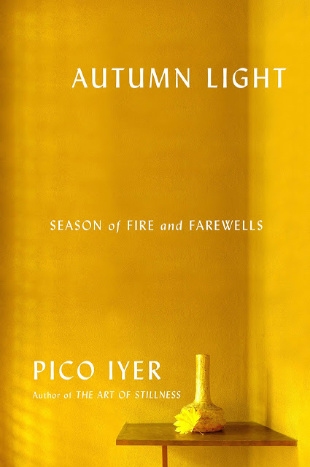In The Art of Stillness, the elegant writer and journalist Pico Iyer used creative imagery and fresh insights to convey the wisdom and the peacefulness to be discovered in stillness. In his other works, he has explored the benefits of travel and of staying put. He is also a popular Ted Talks speaker, reaching more than 800 million views. Iyer rides the surf of such global popularity because of his genuine spiritual nature and his special gift for writing enchanted and lyrical prose.
In this memoir, Iyer returns from California to his two-room apartment in Kyoto where he lives with his wife Hiroko. Her father has just died. With sadness in his heart, Iyer comments on the spiritual significance of impermanence in Japanese culture; the fragility of life adds sweetness to the loss of those who are near and dear to us. Iyer pauses and reveals that "Autumn poses the question we all have to live with: How to hold on to the things we love even though we know that we and they are dying. How to see the world as it is, yet find light within that truth."
Iyer has a fondness in his heart for Kyoto which is said to be the most visited city in the world outside of Mecca. Always attentive, he looks for little surprises as he watches elders playing ping-pong at the local club he visits almost daily. He is reminded that Japan has the oldest population in the world. On the Festival of the Dead, relatives carry cucumbers in the shape of horses to encourage their ancestors to quickly return.
The author marvels at the way everyone thinks he is old enough to be Hiroko's father. There are so many things about her which fascinate him, such as her devotion to cleaning, her yearning to reconnect with a brother who has abandoned the family, her way of trying to seize each day as a blessing, and her laughter every time they visit England.
There is a lovely sense of intimacy in this memoir filled with Iyer's sweet observations about his wife, friends, and neighborhood. Indirectly, it provides a sense of what Japan is like both as a home and a culture. Mostly, it gives us a poetic image of daily life. Asked to describe the book to Hiroko, Iyer says, "When I came here, I was so taken by everything that was different, full of drama, so distinctly Japanese. . . . Now I see it's in the spaces where nothing is happening that one has to make a life." Her response matches ours to this beautiful book. "Little no-action movie . . . Rain come down window. Car stuck in traffic jam. Quiet music playing. Autumn light." Read and savor the moments.
